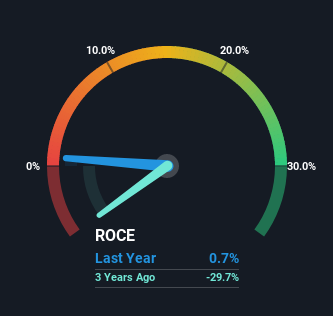- Canada
- /
- Metals and Mining
- /
- TSXV:SNS
Select Sands (CVE:SNS) Is Experiencing Growth In Returns On Capital
To find a multi-bagger stock, what are the underlying trends we should look for in a business? One common approach is to try and find a company with returns on capital employed (ROCE) that are increasing, in conjunction with a growing amount of capital employed. Basically this means that a company has profitable initiatives that it can continue to reinvest in, which is a trait of a compounding machine. With that in mind, we've noticed some promising trends at Select Sands (CVE:SNS) so let's look a bit deeper.
Understanding Return On Capital Employed (ROCE)
If you haven't worked with ROCE before, it measures the 'return' (pre-tax profit) a company generates from capital employed in its business. The formula for this calculation on Select Sands is:
Return on Capital Employed = Earnings Before Interest and Tax (EBIT) ÷ (Total Assets - Current Liabilities)
0.0074 = US$107k ÷ (US$20m - US$5.7m) (Based on the trailing twelve months to September 2022).
So, Select Sands has an ROCE of 0.7%. On its own that's a low return on capital but it's in line with the industry's average returns of 1.2%.
See our latest analysis for Select Sands

Historical performance is a great place to start when researching a stock so above you can see the gauge for Select Sands' ROCE against it's prior returns. If you're interested in investigating Select Sands' past further, check out this free graph of past earnings, revenue and cash flow.
What Does the ROCE Trend For Select Sands Tell Us?
It's great to see that Select Sands has started to generate some pre-tax earnings from prior investments. The company was generating losses five years ago, but now it's turned around, earning 0.7% which is no doubt a relief for some early shareholders. Additionally, the business is utilizing 28% less capital than it was five years ago, and taken at face value, that can mean the company needs less funds at work to get a return. This could potentially mean that the company is selling some of its assets.
For the record though, there was a noticeable increase in the company's current liabilities over the period, so we would attribute some of the ROCE growth to that. The current liabilities has increased to 28% of total assets, so the business is now more funded by the likes of its suppliers or short-term creditors. Keep an eye out for future increases because when the ratio of current liabilities to total assets gets particularly high, this can introduce some new risks for the business.
In Conclusion...
From what we've seen above, Select Sands has managed to increase it's returns on capital all the while reducing it's capital base. Although the company may be facing some issues elsewhere since the stock has plunged 88% in the last five years. Regardless, we think the underlying fundamentals warrant this stock for further investigation.
If you'd like to know about the risks facing Select Sands, we've discovered 2 warning signs that you should be aware of.
While Select Sands isn't earning the highest return, check out this free list of companies that are earning high returns on equity with solid balance sheets.
New: Manage All Your Stock Portfolios in One Place
We've created the ultimate portfolio companion for stock investors, and it's free.
• Connect an unlimited number of Portfolios and see your total in one currency
• Be alerted to new Warning Signs or Risks via email or mobile
• Track the Fair Value of your stocks
Have feedback on this article? Concerned about the content? Get in touch with us directly. Alternatively, email editorial-team (at) simplywallst.com.
This article by Simply Wall St is general in nature. We provide commentary based on historical data and analyst forecasts only using an unbiased methodology and our articles are not intended to be financial advice. It does not constitute a recommendation to buy or sell any stock, and does not take account of your objectives, or your financial situation. We aim to bring you long-term focused analysis driven by fundamental data. Note that our analysis may not factor in the latest price-sensitive company announcements or qualitative material. Simply Wall St has no position in any stocks mentioned.
About TSXV:SNS
Low and slightly overvalued.
Market Insights
Community Narratives




